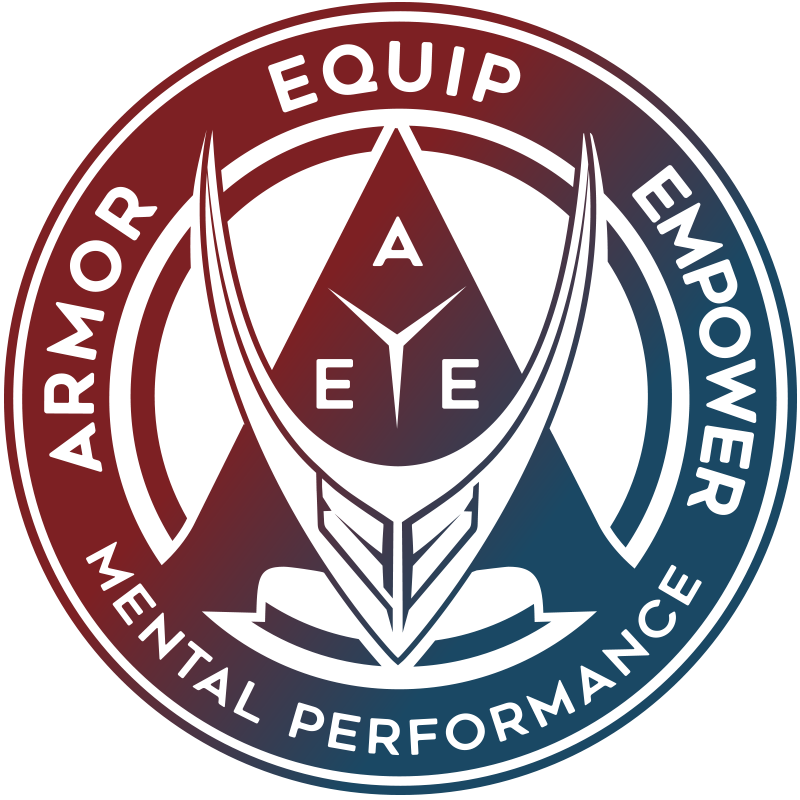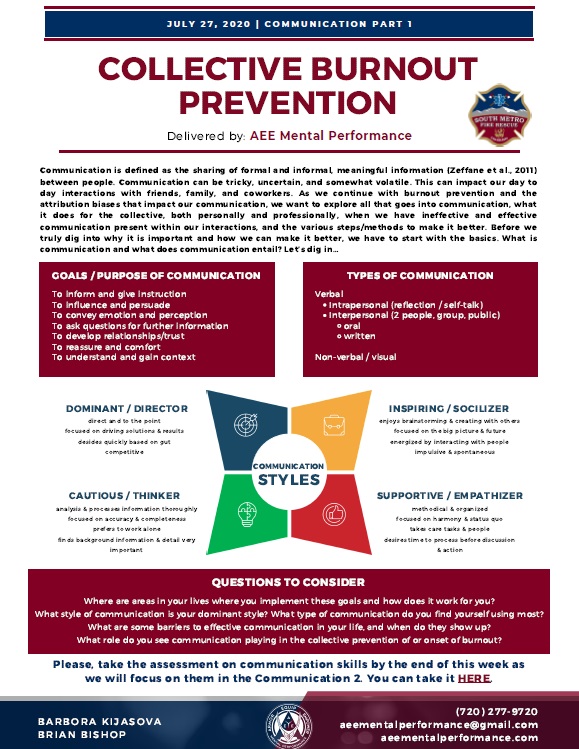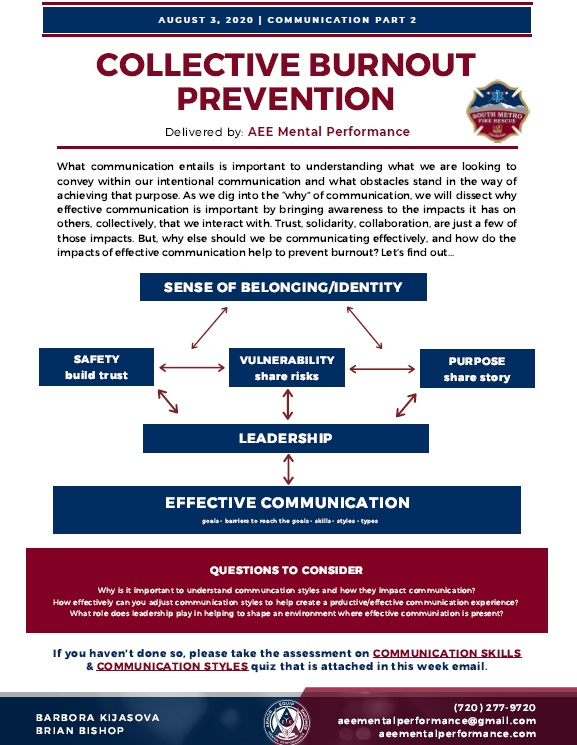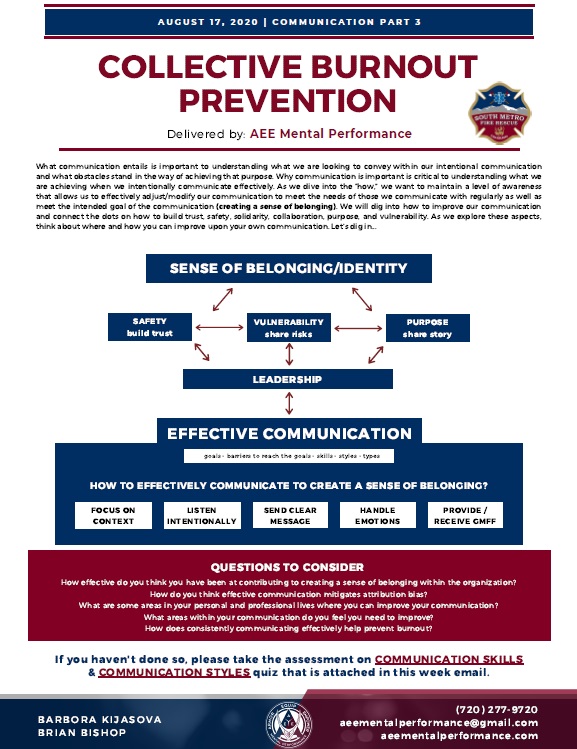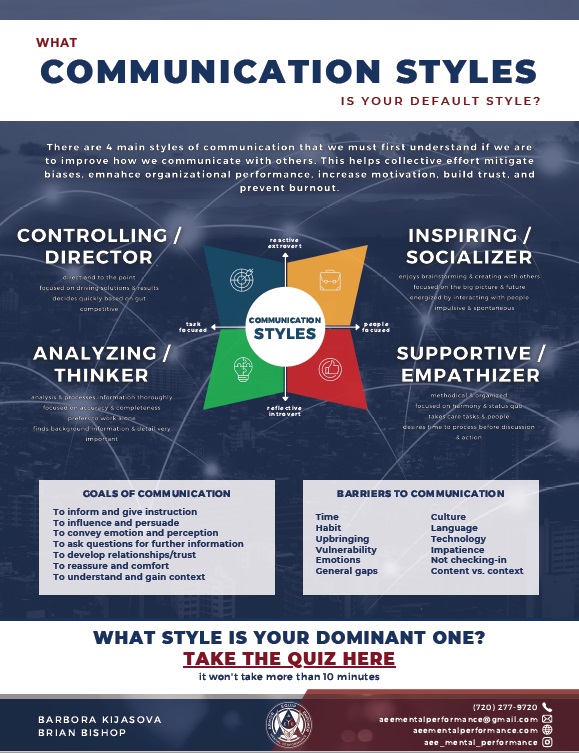lesson 3:
INTENTIONAL communication
Downloadable handouts:
Attribution bias and its impact on communication
As we introduced attribution biases we know that these assumptions can have a major impact on how we communicate within the organization or even at home. When attribution bias is present, there is a higher chance of misunderstandings, less cooperation, lack of growth feedback, lack of social support, etc. This creates a negative spiral effect to communication across the organization.
However, effective communication facilitates/promotes understanding which mitigates attribution bias.
What is communication
Communication is defined as the sharing of formal and informal, meaningful information between people (Zeffane et al., 2011).
This includes the Growth Mindset Focused Feedback (GMFF) we discussed previously. GMFF cannot happen without communication! If we are not communicating, we are not providing GMFF. Of additional importance is that fact that communication is just as much about listening as it is about conveying. What are we listening for to help us convey the appropriate feedback?
Goals of communication
There are several goals/purposes of communication and it is imperative that we understand what our goal is as we seek to communicate with others. These goals include:
- To inform and give instruction
- To influence and persuade
- To convey emotion and perception
- To ask questions for further information
- To express/seek wants and needs
- To develop relationships/trust
- To reassure and comfort
- To work as one body in the organization (human body analogy)
Which of these are most important for you in the workplace?
Which of these do you think you could apply more often or improve?
Barriers to effective communication
The road to improving upon our communication does not come without its challenges. These are what we call barriers to effective communication. If we are seeking to improve our communication, we have got to first understand and be able to identify what’s standing in the way. Understanding and overcoming these barriers helps us to better achieve the intentional purpose behind our communication. These barriers come in all shapes and sizes and include:
These barriers are interconnected and impact each other to some extent. When one is present, others may be present as well. We want to tune in so we recognize these barriers and mitigate their impact on our communication.
What are some barriers to effective communication in YOUR life, and when do they show up?
COMMUNICATION STYLES
By learning about different styles, you can learn:
- What is your default “go-to” style (defining beginning of each communication and when the stress is high)
- What default style are others –> how to meet them within their style
What style helps reach a specific communication goal - How flexible you are at switching between styles
- Can you define the right style for the right situation/person
- Do you utilize the right style in the right situation/for the right person
- How often/well do you utilize them
How can understanding communication styles, as a barrier, help improve communication and achieve the intended purpose/goal of your communication?
What is your default/dominant communication style?
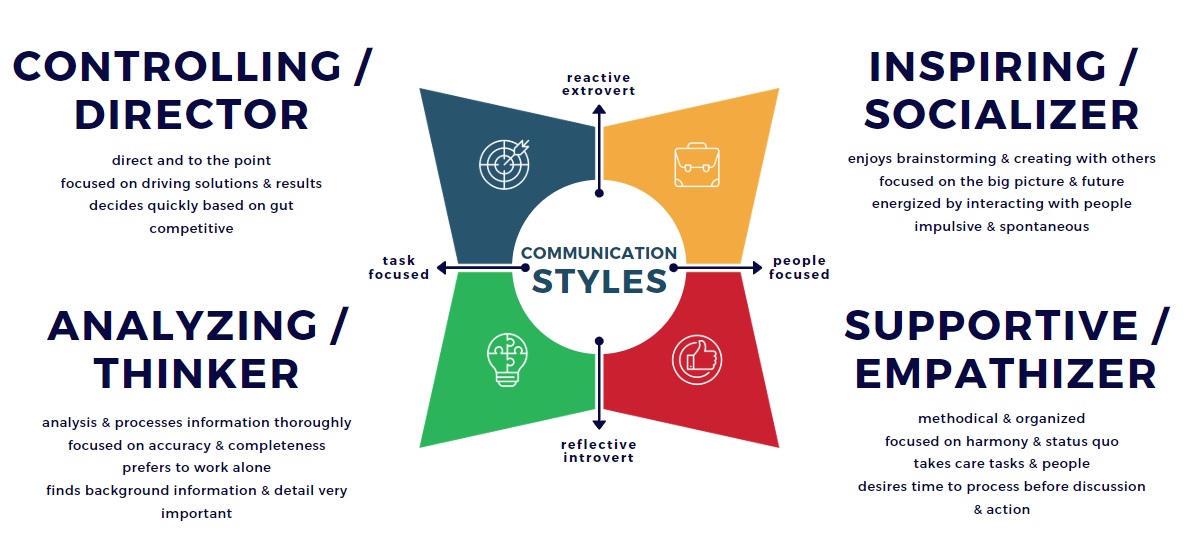
Styles explained:
Please take the quiz below to gain a better understanding of:
- What your dominant communication style is
- How your style manifests
- How do other styles manifest
- Additionally, think about this: Why is it important to understand your default/dominant style of communication?
What are the typical traits of your style?
Do you know the styles of your colleagues and your family members?
How do you meet needs of other styles?
Types of communication
To better understand our styles and how they play a role in our communication with others, its important we understand the types of communication that exist and how we see our style being used within that type.
- Verbal (oral / written)
- intrapersonal – reflection and self-talk from resilience
- interpersonal (between people; CBP)
- small group (AAR, staff meeting)
- public
- non-verbal / visual
the why
Communication conection to burnout
What does reseach tell us?
- One of the factors contributing the burnout of nurses (helping profession) is their difficult and complicated relations (communication) with patients and other members of the medical team.
- Organizational engagement (i.e. job satisfaction, org. commitment) and communication are strong predictors for burnout
- Functional perspective (information over/underload)
- Burnout might be caused by overload (informational overload included)
- Burnout might be caused by lack of feedback (maintaining fixed mindset)
- Burnout can be caused by informational under-load
- Interpretive perspective of communication (satisfaction with total communication environment; climate shared among coworkers; soc. support) was associated with burnout.
What role do you see communication playing in the collective prevention of or onset of burnout?
Why do we want to communicate effectively?
From the collective perspective to burnout prevention, we should examine one factor that has a strong impact on whether one is prone to burnout or not. This factor is a sense of belonging in the organization and personal life.
As you could learn in the previous lesson, those employees in helping professions who lack quality communication with their clients/patients or colleagues are more prone to burnout. Not because the communication is bad but because poor communication fails to create quality connections to others.
This can lead to higher isolation, non-optimal motivation, avoidant/maladaptive coping, lower communication, higher misunderstanding, higher attribution bias…all signs turning into burnout over time.
When we turn it around, a solid sense of belonging works as an armor that protects you from isolation and equips you to act accordingly when facing stressful situations.
The sense of belonging builds when 3 components are at the right place. These components are safety, vulnerability, and purpose. We cannot build those other than by quality, effective, and intentional communication.
On sense of belonging
Video on the connection between vulnerability and safety as well as what you as a leader could utilize to create that powerful combination of safety and vulnerability leading to thriving and collaboration:
Other collective impacts of communicating effectively
Effective communication leads to mitigation of attribution bias:
- Trust develops between coworkers (communication as an antecedent of trust)
- Promotes collaboration, motivation, improves competence development and knowledge sharing, initiation and innovativeness
- Vulnerability is shared and reciprocated between parties
- Collaboration increases
Leading by example (it only takes one to make the change)
Mitigation of attribution biases then facilitates increases in the following areas:
Increased perceptions of Social Support:
- Supportiveness; participative decision making; trust, confidence, and credibility; openness and candor in message sending and receiving; and emphasis on performance goals
- Social support = “information that leads individuals to believe that they are cared for and loved, esteemed, and valued and that they participate in a network of communication and mutual obligation”
- Created by listening, technical support, technical challenge, emotional support, emotional challenge, and sharing social reality.
- Creates an appreciation and reinforcement that success and positive growth come with challenge
- Research has shown that a supervisor’s social support is found to be slightly more influential than coworker social support
- Social support is connecting and engaging which we talked about in GMFF
Increased Solidarity:
- Solidarity defined as: perceived closeness, quality of relationship, harmony, and trust (component of high functioning organizations?)
- Solidarity represents psychological and social closeness between persons generated through trust and self-disclosure
- Also, positively linked to job satisfaction which we touched on in IBP
Increased Self-Determination:
- Autonomy support/growing and learning = higher job satisfaction
- Relatedness – people experiencing burnout lack sense of understanding of others → communication gets more difficult (higher attribution biases) → individuals even more prone to burnout + toxic environment → organization more prone to burnout
- Competence both objective and perceived – acquiring skills through collaboration and growth mindset focused feedback as well as maintaining a growth mindset and optimal motivation that keeps you on track throughout learning new skills and overcoming undesirable situations
As a result of increased self-determination → Participation in decision making, providing feedback → reducing stress, increasing perception of satisfaction and personal accomplishment
the how
Why do we want to know HOW to communicate better?
Message delivery
Message delivery is important to effective communication, but it first starts with understanding the context (intent). Often times we focus solely on the content and this has an impact on how we receive the message. Often times the impact is a misunderstanding. What we are missing is the context (intent) of the communication. To shape a more productive impact for both receiver and provider and create a sense of belonging, we must first identify the intended goal of the communication.
context (goals, intent) → content → impact
What is content: content is the details, story, perceptions, what, who, where, when, why, how.
What is context: Context is intention (i.e. What do I want to think? What do I want the other person to think? What do I want to feel or others to feel? What environment am I shaping? (“I’m here to set you up.” “I’m here to support you.”)
Define goal/intention of each communication (increases growth mindset, makes the communication more meaningful and intentional, and more controlled, it allows you to reflect if you used the right content to reach the goal) – Know what your purpose is!
How to improve communication skills?
Before we get into how to improve communication skills, let’s explore how good we actually are at them:
Listening skills
Implement active listening techniques:
- The speaker will feel more at ease leading to more open, closer and honest communication
- Non-verbal signs – smile, eye contact, posture, mirroring, you don’t get distracted (stay tuned in)
- Verbal signs – positive reinforcement, remembering, questioning, reflection, clarification, summarizing
Overcome distractions (emotions, technology, other tasks, people, thoughts) - not paying attention gets in the way of TRULY listening
- Be present
- Remain flexible
- Don’t take it personal
- Apply active listening techniques
- Develop awareness of different listening styles (below)
Apply appropriate type of listening
Except for selective listening, each style has its place and it’s important to be aware of the style being used at the time and effectively switching to create a connection and contribute to maintaining a sense of belonging within the team or organization.
- information listening (listening to learn; less active)
- critical listening (listening to evaluate and analyze and make judgement; more active; usually involves critical problem-solving or decision making)
- It’s important to be open-minded, and not biased by stereotypes or preconceived ideas → broadening your knowledge and perspectives
- therapeutic or empathetic listening (listening to understand feelings/emotions): Try to understand other point of view (emotionally)
- Try to put the speaker’s shoes on; connects to the speaker, it’s more than sympathy
- Doesn’t involve judgement or offer advice
- Encourages the speaker to explain and elaborate on their situation, feelings, and emotions
- appreciative listening – listening for enjoyment (music, someone we feel good with)
- rapport listening – to promote trust (achieved through active listening)
- selective listening – more negative; when you filter out some of the message
Determine what the underlying needs are that are driving the other person’s demands (needs can still be met through different demands).
Identify areas of common ground or shared interests that you can work from to develop solutions (most effectively achieved when truly and intentionally listening to what is being communicated)
Let’s tackle how to improve sending clear messages:
Sending clear message
Verbal signals
- positive, clear meaning, logical, minimal jargon, suit your audience (styles, roles)
There is a common misconception that words are the most important part of communication. This misinterpretation comes from the 6% study where in actuality, words are very important more than 6%
Vocal/paraverbal
- tone, emphasis, level, pitch, speed
These convey your attitude and emotion towards the communication. Those anxious or nervous tend to speak more quickly.
Non-verbal
Facial, posture, gestures, touch, distance
- Also determine your attitude and emotion
- For people who are used to do more gestures, you giving less gestures might be perceived as less approachable and authoritarian
- Open posture signals you’re more supportive; but if you’re too relaxed and lack eye contact you might be perceived as uninterested
What aspects of sending a clear message do you think you need to work on to get your message across and create the sense of belonging; and how does it look?
Something that might help in sending a clear message is assertiveness
Assertiveness is the quality of being self-assured and confident within your communication without being aggressive. It means to be able to stand up for yourself and for others in a calm, positive way. Assertive people are able to get their point across without upsetting others or becoming anxious or upset themselves. It’s the opposite to passive or aggressive. It’s honest, direct, and appropriate.
Tips for how to be more assertive:
- Respect thoughts, feelings and beliefs of others, listen to them
- Take others’ rights, wishes, wants, needs, and desires into consideration, listen to them
- Accept your responsibilities and be able to delegate them to others
- Regularly express appreciation of others for what they have done or are doing
- Admit mistakes and apologize
- Behave as an equal to others
When you respond passively, you present yourself in less positive light and might become inferior to others. This might happen due to poor self-confidence and self-esteem, it can further reduce self-worth (vicious cycle)
When responding aggressively, other’s rights and self-esteem are undermined.
Providing/receiving feedback
- Improve this area if weak for you how we discussed in Lesson 2: Growth mindset focused feedback
- Ask questions to allow them to clarify and to help you understand their perspective
Handling emotional interactions
Emotions aren’t consciously controlled. They are primarily created in amygdala, one of the oldest parts of the brain, which turns on especially when the brain perceives a threat. Given that amygdala works, so to speak, automatically, what we can do at a specific moment when they arise is to recognize (notice) them and accept them. Fighting emotions is like fighting thoughts – it creates even more thoughts and emotions. Recognition + acceptance → you create a space between the stimulus and response with equanimity (calm approach towards the emotions and to what is going on resulting in composure). In that space also lies room for rational, clear thinking and decisions. As a result, you appropriately respond rather than irrationally react.
Prepare for a difficult conversation, be proactive – preparation is the main prerequisite for confidence, with confidence stress decreases
This starts with first handling your own emotions. Below are some tips:
- Do not view the conflict as a contest you are trying to win
- Breathe
- Stay Present
- Really listen
- Take a break
Then you create the flexibility to appropriately communicate for effectively handling emotions:
- Listen carefully and provide verbal and nonverbal feedback
- Distinguish the people from the problem (don’t take it personal)
